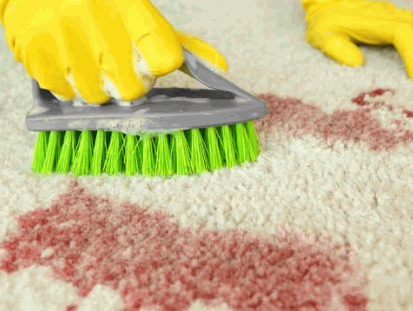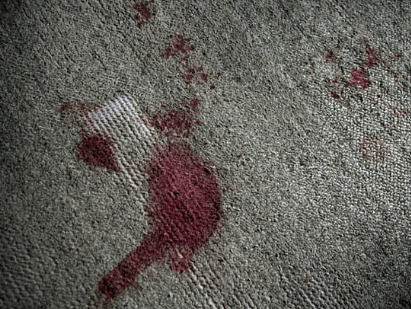Blood stains are notorious for being extremely difficult to remove so you would be forgiven for thinking that it's all over for your carpet as soon as you spill some blood on it. But, while it is true that blood is one of the most difficult materials to remove, there are methods out there that can do a good job of lifting the stain. So all is not necessarily lost! Let's take a look at why blood is so difficult to remove and what methods can address these issues.
Blood is a complex liquid. It contains a variety of different molecules, including proteins, fats, and iron, each of which can complicate the stain remover process. Understanding these can help you come up with solutions for how to tackle removing a blood stain because different approaches work best for different blood molecules.
Our post "How To Clean Carpet Stains" maybe interest you. You can check it out.

Blood contains plasma proteins such as globulin and albumin. If you have ever heard that you should never use warm or hot water to clean a blood stain, the proteins are why.
When these proteins are heated, it triggers a reaction that causes them to bind together strongly. This will make the blood stain even more difficult to remove than it was before.
Fats and grease also cause notoriously difficult-to-remove stains. This is because lipids (fats) are insoluble in water. So standard methods that involve washing with water won't lift the fats in the blood from your carpet on their own. This will mean that some of the blood stains are left behind.
Most of the molecules in your blood are organic, including proteins and fats. But blood also contains iron which is an inorganic material. Because of this, a blood stain remover that works on the principle of breaking organic materials down into smaller molecules won't work to lift the iron.
Another element that makes blood stains difficult to remove is the clotting process itself. When you cut yourself, blood flows out and (as long as the blood flow isn't too heavy) it very quickly starts to form a clot over the wound. This is an important process that works to stem the flow of bleeding and to form a seal that prevents bacteria from getting in through the wound.
Blood that is spilled on a carpet will go through the same clotting process. This time, however, instead of knitting together to protect a wound, it will knit together with the carpet fibres, making the stain more difficult to clean.
Speed is of the essence when blood spills on a carpet. Getting to the stain before the clotting process happens will make removing it far easier (more on how to remove dried blood stains later). As soon as you see the blood stain, you should douse it thoroughly with cold water (remember never to use hot or warm water). This will keep the blood wet and prevent it from clotting while you work on getting it removed.
Use a damp rag to blot the stain and remove as much of the blood as you can with just cold water while it is fresh. Fresh blood stains haven't had time to soak into the carpet fibres so you have a good chance of removing the majority of the blood if you can get to it quickly enough.
One of the molecules that makes it difficult to get blood out of the carpet is the proteins. A standard detergent solution may not be as effective as you might like because it can struggle with shifting larger protein molecules.
An enzyme cleaner will contain protease. This is the enzyme that breaks proteins down into smaller molecules which are then easily soluble in water.
Follow the directions on your enzyme stain remover and apply it to the blood stain. Then go in and gently blot the area with a damp white cloth and cold water. It is important to blot and not rub because rubbing can spread the stain out even further.
Finally, use a dry cloth to remove excess water and check if the blood stain has fully lifted from the carpet pile. You could also use a wet vac to remove the water.
Fats create stubborn stains because they are not soluble in water. In the same way, the fats found in blood also won't be soluble in water.
An effective stain remover for fats and grease is white vinegar. This is because the acetic acid in the vinegar can cut through the fats and lift them. Remember not to use apple cider vinegar as the pigment in this can stain your carpet.
Create a cleaning solution of one part white vinegar to two parts cold water in a spray bottle. Liberally spray the blood stain and gently blot it with a wet cloth. Then go back in and dry with a clean cloth to see if the stain has disappeared.

Another method of getting blood out of the carpet by removing the fats is to use baking soda and dish soap. Baking soda lifts the fats from the carpet fibres and the dish soap will break up what remains.
Sprinkle the wet blood stain with baking powder and add a drop of liquid dishwashing detergent and wait for ten minutes. Then scrape the excess blood and baking powder away with a butter knife. Sprinkle some more baking soda on the stain and scrub it using a soft brush. Wait for it to turn brown, then scrape it away again. Repeat this process until the baking powder doesn't change colour.
Next, make a liquid detergent and water solution in a spray bottle (use a couple of drops of detergent). Spray it on the area and blot it with a cloth. Repeat this cleaning process until all the blood is gone.
You will need to remove the soapy residue using clean cold water and clean cloth before drying.

Most cleaning solutions to remove blood stains will focus on the organic compounds in the blood, but they aren't as effective on the inorganic iron. A simple method for breaking down the iron compounds is to use a salt paste.
Mix a small amount of water with enough salt to create a thin paste. Apply this paste to the entire blood stain and then leave it for five minutes.
Next, go in with cold water and a damp cloth and blot the area thoroughly before drying with a clean cloth or wet vac.
If blood stains weren't bright red, they would be much easier to remove. Thankfully, you can deal with the red pigment directly by using an oxygen bleach. Hydrogen peroxide (most often used to bleach hair) doesn't contain harmful chlorine and is effective at removing blood stains.
If hydrogen peroxide alone doesn't do the job, you can use something like Oxi-Clean. This is most often used to make white clothes whiter again using a bleaching method and it can also work well to remove blood stains.
It is more powerful than just hydrogen peroxide because it also contains tetraacetylethylenediamine (TAED), which is a bleach activator. Mixing the two creates peracetic acid which is a powerful bleaching agent.
Always remember when using bleach to test it on a small inconspicuous area of your carpet first. There is a chance that it could cause discolouration so you should always test it before using it on a noticeable spot.
Once you are satisfied that the bleach won't stain your carpet, saturate the stain with the solution and blot with a white cloth. Then go back in with cold water alone and a damp cloth to remove the excess solution before drying.

A dry blood stain is trickier to remove than a fresh blood stain. This is because the clotting process has been completed and the fibrous blood molecules have been woven into the carpet fibres. Because of this removing dried blood stains will often take a bit more effort and elbow grease but it can be done.
The first thing you need to do is to remove the loose dry blood. Do this before you start adding any liquid to the stain. If it is dry and loose, it will be relatively easy to remove but it will get more difficult once you wet it.
Use a steel brush or other hard brush to gently scrape away the dried blood then use a vacuum cleaner to remove it. Once you get to the point where you can't scrape any more dried blood off, then you need to start thinking about wetting the stain again.
Use cold water to fully saturate the dried blood. You need the water to soak deep into the carpet fibres so that it reaches every part of the stain.
Then you can start using the various blood stain remover cleaning methods. Now that the stain is wet, these methods will become effective again.
Check out: How To Clean Sick Off Carpet

If you need to remove blood stains from a carpet, these DIY methods can be effective but if they aren't then bringing in a professional is a good solution.
A professional cleaning company will have access to industrial-grade carpet stain remover products and cleaning equipment. They will also have the knowledge, training, and experience to understand blood stains, how they interact with the carpet material type, and the best approach to use to remove them.
For more learnings, you can check out our post "How Much Is Carpet Cleaning".

If you have blood stains on your carpet that are proving impossible to remove, don't hesitate to get in touch with the Carpet Team. We are a trustworthy company with many years of experience dealing with carpet stains of all kinds (including blood). Our highly-trained team of cleaning professionals will work with you to assess the stain and develop a plan for how to remove it most effectively. And we can work around your schedule to come to your property at a time and date that suits you.